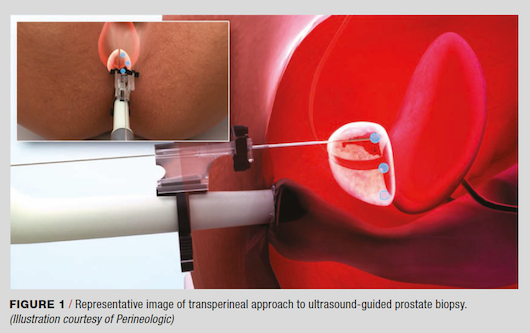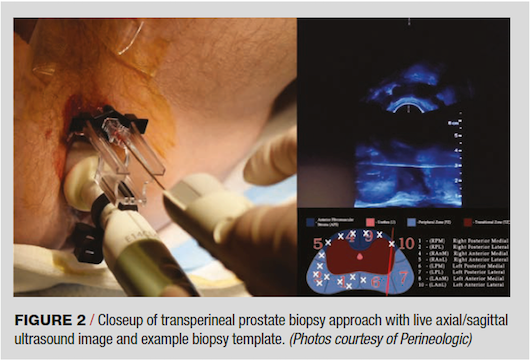Publication
Article
Urology Times Journal
The case for transperineal prostate biopsy vs. the transrectal approach
Author(s):
Reduced infection rate may drive increased use of the transperineal approach.
Prostate cancer is the most common non-dermatologic cancer in men, with approximately 164,690 cases identified in 2018 alone, accounting for almost one-fifth of new cancer diagnoses (CA Cancer J Clin 2018; 68:7–30).
The diagnosis of prostate cancer has evolved since Hugh Hampton Young first described the open perineal prostate biopsy in 1926 (Young’s Practice of Urology. Vol 1. Philadelphia: W.B. Saunders; 1926). For the past 3 decades, urologists have primarily relied on ultrasound-guided transrectal needle biopsy (TR-Bx) and a sextant approach for diagnosis. More recently, extended biopsy schemes involving 12 cores have been employed (Eur Urol 2017; 71:618–29).
Unfortunately, there are various drawbacks to the transrectal approach including suboptimal diagnostic accuracy and various procedure-related complications. The transperineal approach (figures 1 and 2) is slowly gaining traction around the country, given its promise to address many of these issues.

So why are many urologists still struggling to abandon the transrectal approach in favor of the transperineal approach? In the famous words of the esteemed British economist, John Maynard Keynes, “The difficulty lies not so much in developing new ideas as in escaping from old ones.”
Pitfalls of transrectal biopsy
In 1989, Hodge et al published the landmark article demonstrating improved diagnostic accuracy with a systematic sextant approach and ushered in the modern era of transrectal prostate biopsy (J Urol 1989; 142:71-4). Various groups improved upon these concepts in the late 1990s by increasing accuracy via augmented sampling (J Urol 1997; 157:199-202; J Urol 1998; 159:471-5; Urology 1999; 53:961-7).
Despite this systematic approach, TR-Bx has always maintained a high false-negative rate, missing approximately one-third of clinically significant cancers (J Urol 1989; 142:66-7). Additionally, TR-Bx results were understaged in up to 25% of men based on final pathology following radical prostatectomy (Urology 2008; 72:177-82). Thanks to the emergence of multiparametric magnetic resonance imaging in fusion TR-Bx, however, urologists have made significant strides in addressing the concerns related to prostate cancer diagnosis (Eur Urol 2016; 70:233-45).

Unfortunately, one issue that remains unaddressed is the rising incidence of infectious complications after TR-Bx in the era of antimicrobial resistance. Halpern et al reported that rates of infection within 30 days of TR-Bx increased from 2.6% to 3.5% from 2011 to 2014 in New York (J Urol 2017; 197:1020-5). Furthermore, post-TR-Bx sepsis is significant not only in terms of outcomes, but also in terms of spending, ranging from approximately $8,500 to $19,000 over the past 10 years (Urology 2019; 133:11-5). If bacterial resistance to fluoroquinolones is increasing, it is reasonable to assume that complications will continue to climb (Urology 2011; 78:511).
Next: Advantages of transperineal approach
Advantages of transperineal approach
Holm described the first transrectal ultrasound-guided transperineal prostate biopsy (TP-Bx) in 1981 (J Urol 1981; 126:385). This approach has seen a resurgence in clinical practice due to its superiority in sampling both the anterior prostate and apical region (Cancer 2005; 103:1826-32; Eur Urol 2006; 50:266-71).
Multiple systematic reviews and meta-analyses have demonstrated equivalent prostate cancer detection rates between TR-Bx and TP-Bx (Asian J Androl 2012; 14:310-5; World J Surg Onc 2019; 14:31). However, the major driver for increased interest in TP-Bx has been the associated reduction in infection rates. Pepe reported a series of 3,000 patients with an infections complication rate under 1%, and a meta-analysis conducted by Grummet reported a sepsis rate of less than 0.1% (Urology 2013; 81:1142-1146; BJU Int 2014; 114:384–8).
While these outcomes may exhibit an improvement for TP-Bx over TR-Bx, there are concerns about potential drawbacks leading to a slow rate of acceptance. These concerns seem to be rooted in the perceived need for general anesthesia and increased cost. While the TP-Bx approach has historically been described in the setting of general anesthesia, recent papers have demonstrated efficacy with local anesthetic techniques and acceptable patient-reported tolerability outcomes (BJU Int 2017; 120:164-7; Prostate Cancer Prostatic Dis 2017; 20:311-7). Additionally, while TP-Bx has traditionally been performed using a brachytherapy grid and stepper, free-hand approaches to TP-Bx have been shown to minimize costs associated with instrumentation in the outpatient setting (J Urol 2016; 195:e466-7).
Conclusion
A plethora of research is growing that suggests TP-Bx offers equivalent prostate cancer detection rates, lower infectious complications, and increased technical feasibility. The ubiquitous adoption of office-based transperineal prostate biopsy appears to be imminent.


Section Editor Christopher M. Gonzalez, MD, MBA, is professor and chair of the department of urology at Loyola University Chicago Stritch School of Medicine, Maywood, IL.
































